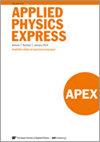晶粒尺寸对Nd-Fe-B纳米磁体矫顽力的影响:基于多晶粒模型的微磁学模拟
IF 2.2
4区 物理与天体物理
Q3 PHYSICS, APPLIED
引用次数: 4
摘要
采用多晶模型结合混合蒙特卡罗方法模拟了纳米晶钕铁硼磁体的矫顽力。用晶界(GB)模型模拟的碳氢化合物晶粒尺寸关系与现有实验结果吻合较好。直接接触(DC)模型的H - c随晶粒尺寸(S - G)的减小而增大,这表明即使平均S - G减小到几十纳米,Nd-Fe-B磁体的H - c也可以通过晶粒细化进一步提高。通过磁化反转分析,了解了gb模型和dc模型矫顽力机理的差异。本文章由计算机程序翻译,如有差异,请以英文原文为准。
Grain-size effect on coercivity of Nd–Fe–B nanomagnets: micromagnetics simulation based on a multi-grain model
The coercivity (H c) of nanocrystalline Nd–Fe–B magnet was simulated by multi-grain models in combination with hybrid Monte Carlo method. The simulated grain size dependence of H c with grain boundary (GB) model reproduces the available experiment nicely. The H c of direct contact (DC) model increase with the decreasing grain size (S G). This fact suggests that the H c of Nd–Fe–B magnets can be further increased by grain refinement even though the average S G down to several tens of nanometers. The difference of coercivity mechanism between GB-model and DC-model was understood by magnetization reversal analysis.
求助全文
通过发布文献求助,成功后即可免费获取论文全文。
去求助
来源期刊

Applied Physics Express
物理-物理:应用
CiteScore
4.80
自引率
8.70%
发文量
310
审稿时长
1.2 months
期刊介绍:
Applied Physics Express (APEX) is a letters journal devoted solely to rapid dissemination of up-to-date and concise reports on new findings in applied physics. The motto of APEX is high scientific quality and prompt publication. APEX is a sister journal of the Japanese Journal of Applied Physics (JJAP) and is published by IOP Publishing Ltd on behalf of the Japan Society of Applied Physics (JSAP).
 求助内容:
求助内容: 应助结果提醒方式:
应助结果提醒方式:


